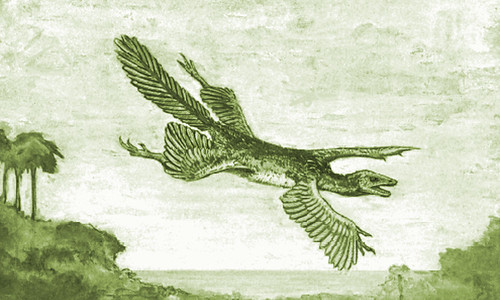The weight of the evidence is now suggesting that not only did birds not descend from dinosaurs, but that some species now believed to be dinosaurs may have descended from birds, according John Ruben, a professor of zoology at Oregon State University who authored the PNAS commentary.
"We're finally breaking out of the conventional wisdom of the last 20 years, which insisted that birds evolved from dinosaurs and that the debate is all over and done with," Ruben said. "This issue isn't resolved at all.'

An image drawn in 1915 by naturalist William Beebe suggests a hypothetical view of what early birds may have looked like, gliding down from trees - and it bears a striking similarity to a fossil discovered in 2003 that is raising new doubts about whether birds descended from ground-dwelling theropod dinosaurs. (Photo courtesy of Oregon State University)
The most recent evidence comes from an analysis of "microraptor," in which three-dimensional models were used to study its possible flight potential. The remarkable fossil specimen had feathers on all four limbs, somewhat resembling a bi-plane. Glide tests based on
its structure concluded it would not have been practical for it to have flown from the ground up, but it could have glided from the trees down, somewhat like a modern-day flying squirrel. Many researchers have long believed that gliders such as this were the ancestors of modern birds.
"This model was not consistent with successful flight from the ground up, and that makes it pretty difficult to make a case for a ground-dwelling theropod dinosaur to have developed wings and flown away," Ruben said. "On the other hand, it would have been quite possible for birds to have evolved and then, at some point, have various species lose their flight capabilities and become ground-dwelling, flightless animals – the raptors. This may be hugely upsetting to a lot of people, but it makes perfect sense."
Ruben says it's more likely that birds may have had an ancient common ancestor with dinosaurs, but they evolved separately on their own path, and after millions of years of separate evolution birds also gave rise to the raptors. Small animals such as velociraptor that have generally been thought to be dinosaurs are more likely flightless birds.
"Raptors look quite a bit like dinosaurs but they have much more in common with birds than they do with other theropod dinosaurs such as Tyrannosaurus," Ruben said. "We think the evidence is finally showing that these animals which are usually considered dinosaurs were actually descended from birds, not the other way around."
In their own research, including one study just last year in the Journal of Morphology, OSU scientists found that the position of the thigh bone and muscles in birds is critical to their ability to have adequate lung capacity for sustained long-distance flight, a fundamental aspect of bird biology. Theropod dinosaurs did not share this feature.
Other morphological features have also been identified that are inconsistent with a bird-from-dinosaur theory. And perhaps most significant, birds were already found in the fossil record before the elaboration of the dinosaurs they supposedly descended from. That would be consistent with raptors descending from birds, Ruben said, but not the reverse.
OSU research on avian biology and physiology has been raising questions on this issue since the 1990s, often in isolation. More scientists and other studies are now challenging the same premise, Ruben said. The old theories were popular, had public appeal and "many people saw what they wanted to see" instead of carefully interpreting the data, he said.
"Pesky new fossils...sharply at odds with conventional wisdom never seem to cease popping up," Ruben wrote in his PNAS commentary. "Given the vagaries of the fossil record, current notions of near resolution of many of the most basic questions about long-extinct forms should probably be regarded with caution."
John Ruben, 'Paleobiology and the origins of avian flight', PNAS, February 9, 2010; doi:10.1073/pnas.0915099107





Comments